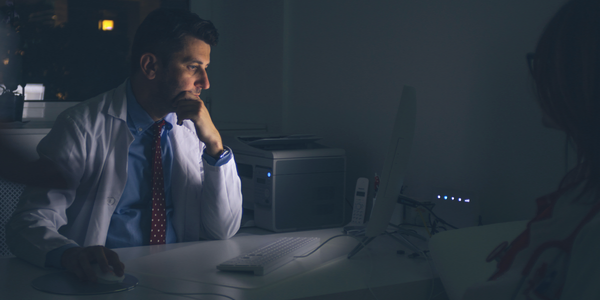
There’s a reason blood pressure is considered a vital sign. Blood pressure ranges can indicate heart health, and a healthy blood pressure daily pattern is crucial to reducing cardiovascular disease risk.
If you’re wondering about the best times to take blood pressure and what is considered low or high levels, you've come to the right place. Read on for a normal blood pressure range by age, gender, and so much more.
Blood Pressure Ranges
When monitoring blood pressure, it’s first important to understand what blood pressure numbers mean. Blood pressure reads like a fraction, with one number on top of another. For example, a normal blood pressure is 120/80 mmHg.
Systolic blood pressure is on top and indicates how much pressure is in the arteries during a heart contraction—when the heart empties and decreases in size. The diastolic blood pressure, the bottom of the fraction, measures between beats as the heart falls.
Thinking of arteries like pipes in a plumbing system can help illustrate changes in blood pressure. Just like pipes can burst when the pressure becomes too high, prolonged high blood pressure in the body can strain the arteries and heart.
While low pressure might not necessarily be as dangerous, a plumbing system—like your heart and circulation—won’t be functioning properly if the pressure is too low.
What Is Considered Low Blood Pressure?
Unlike high blood pressure, there is typically no number or range that defines low blood pressure. When measured in a hospital setting, 90/60 mmHg may qualify as concerning. However, a number that may be concerning for one person may be perfectly normal for another person.
Usually, a healthcare professional can help you decide what blood pressure is “too low” for you. In most cases, low blood pressure that is considered too low will be accompanied by troubling symptoms.
Low blood pressure, plus any of the following symptoms, is reason to be alarmed:
• Changes in vision (i.e. faded or blurred vision)
• Dehydration or extreme thirst
• Feeling dizzy, lightheaded, or fainting
• Feeling extremely tired or fatigued
• Mood changes (i.e. depression)
• Nausea or vomiting
• Skin becoming cold, clammy, or pale
• Taking rapid, shallow breaths
• Trouble concentrating or a sense of confusion
Blood pressure that is too low should be taken just as seriously as blood pressure that is too high. In some cases, low blood pressure can be a sign of a serious or life threatening condition.
Some concerning causes of low blood pressure include:
• Allergic reactions (i.e. anaphylaxis)
• Decrease in blood volume (i.e. major trauma, severe internal bleeding)
• Endocrine issues (hormone problems)
• Heart problems (i.e. heart failure)
• Neurally mediated hypotension (orthostatic hypotension or a blood pressure drop after standing for long periods, often due to miscommunication between heart and brain)
• Nutrient deficiencies (i.e. anemia)
• Severe infection (i.e. septic shock)
What Is Considered High Blood Pressure?
The levels of elevated and high blood pressure are well-defined when compared to low blood pressure. Consistently elevated blood pressure can be a warning sign for high blood pressure. Blood pressure falling in the following ranges can be concerning:
• Elevated: 120-129 mmHg systolic and less than 80 mmHg diastolic
• High Blood Pressure/Hypertension Stage I: 130-139 mmHg systolic or 80-89 mmHg diastolic
• Hypertension Stage II: 140/90 mmHg or higher
• Hypertensive Crisis: 180 mmHg systolic and/or 120 mmHg diastolic or higher
Both stages of hypertension can be linked with health problems, often requiring medication or major lifestyle changes. These stages are associated with an increased risk for heart attack or stroke.
A hypertensive crisis means immediate medical attention is needed. If you test within this range, it’s recommended to wait five minutes and then test your pressure again. Like low blood pressure, if your elevated pressure is accompanied by symptoms, speak with a health professional immediately or call 911.
When blood pressure is too high and the following symptoms are present, you may be experiencing signs of organ damage or heart attack:
• Change in vision
• Chest or back pain
• Numbness or weakness
• Trouble speaking
Healthy Blood Pressure Daily Pattern
While changes in blood pressure may sound scary, it’s actually normal for blood pressure to fluctuate throughout the day.
Factors Causing Fluctuations
Most notably, position and physical activity can alter blood pressure. Moving from a seated to a standing position can cause an increase in blood pressure, as can a shift from standing to exercising.
Interestingly, “rushing in” to a doctor's appointment can also cause an increase in blood pressure. Talking or actively listening while your blood pressure is being taken can also increase your measurement by around 10 mmHg. For this reason, it’s important to follow your medical provider’s instructions while your blood pressure is being taken—like sitting silently and uncrossing your legs, with your feet, arms, and back supported.
Certain phases of life may also cause changes in blood pressure. For example, it’s normal during pregnancy, especially the first half, or while on prolonged bed rest to have lower blood pressure.
Some foods and beverages can cause changes in blood pressure. Two classic examples are caffeine and smoking, which both cause an increase in blood pressure. Alternatively, some medications may cause lower blood pressure.
Fluid status also matters. Dehydration, in particular, can cause a drop in blood pressure. Alternatively, a full bladder can cause blood pressure to increase by about 10 mmHg.
Daily Patterns for a Healthy Blood Pressure
One way to ensure you stay within a healthy blood pressure range is to monitor your blood pressure at home. Home blood pressure equipment is relatively inexpensive, and checking your blood pressure regularly can help give you peace of mind. You can log your blood pressure readings using pen and paper, or choose a device that records readings automatically.
Attending routine doctor appointments and checkups can help you track your blood pressure. Your doctor can take other conditions or circumstances into account and let you know if your individual measurements are concerning. Doctors can also prescribe medication as needed and refer you to other professionals—such as dietitians or physical therapists—to help you employ lifestyle changes.
Another way to work towards a healthy blood pressure is to eat a heart-healthy diet. For example, the DASH diet can help you avoid hypertension by eating a healthy, well-balanced diet. One of the diet’s most important aspects is lowering sodium (salt), since excessive salt in the diet can increase blood pressure.
Blood Pressure Range by Age and Gender
Typically, blood pressure increases with age due to stiffening arteries. Adults aged 55 years and older will want to be sure to attend regular checkups with their doctor or cardiologist.
Gender may also be a factor affecting blood pressure. As mentioned above, it’s normal for women to have lower blood pressure during the first half of pregnancy.
Women going through menopause may also have higher blood pressure. Alternatively, men under the age of 55 may have high blood pressure.
Blood Pressure Ranges: Final Takeaways
While daily fluctuations in blood pressure are normal, trends outside of the normal range may indicate an issue. Chronically low or high blood pressure can be concerning, and regular visits to your doctor can help address these problems.
Luckily, diets like the DASH diet can help you cope with blood pressure changes outside the norm.







